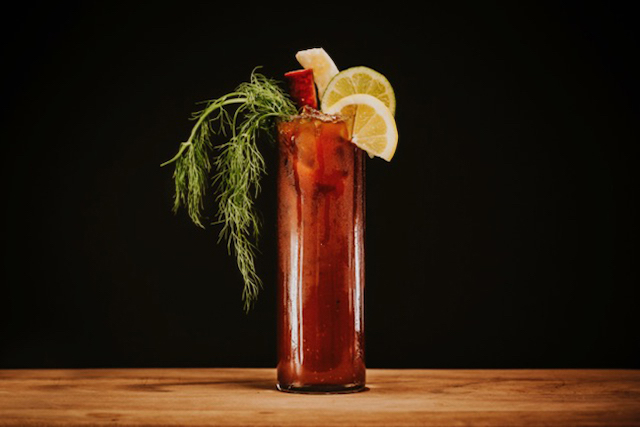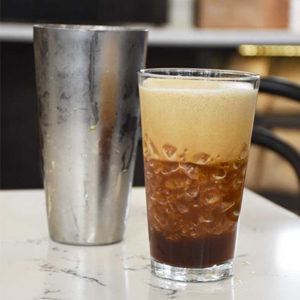Coffee and tomato juice? How about coffee and tonic water? Or coffee and cola? When these unlikely combinations are shaken together by expert baristas, they become delicious mocktails that give patrons a different sort of buzz.
“Baristas have been making these kinds of non-alcoholic coffee cocktails for years,” says Wolfgang Schaefer, director of coffee education for Anodyne Coffee in Milwaukee.
But these cocktails have remained mostly a secret revealed only at barista competitions. “Basically, we spend months working on a drink, then we make it for the judges, and except for perhaps some special events, we never make it again,” says Schaefer.
The secret’s starting to get out, with non-alcoholic coffee cocktails beginning to take their place on the menus at coffee roasteries, bars and restaurants across the country. “With all drinks, it’s about finding that right balance of spirits, bitters, sugar and water, and in non-alcoholic drinks, it’s taking alcohol away from the equation,” says Julia Momose, Chicago bartender and consultant. “Alcohol, in a sense, is a crutch. It has a strong backbone and character, and it’s hard to find ingredients that can take the place of that. But coffee is a great [substitute] because it’s got bitterness, acidity and depending on the beans, it can have different aromas.”
 Wolfgang Schaefer’s Bloody Mary Coffee Cocktail will certainly wake you up, no matter what happened the night before. (Photo: Mann Frau)
Wolfgang Schaefer’s Bloody Mary Coffee Cocktail will certainly wake you up, no matter what happened the night before. (Photo: Mann Frau)
“Coffee also has a viscosity like spirits. It can add a texture to drinks,” Schaefer says. When Schaefer was developing the coffee Bloody Mary, he started with a cold brew, which had the right aromatics. But it wasn’t strong enough to stand up to his homemade tomato and spice mixture, so he used a concentrate of the cold brew, which was thicker.
To bring out the aromas in the cocktail, Schaefer added Fever-Tree ginger beer to a homemade Bloody Mary tomato mix. Then, he added Bittercube Jamaican #1 bitters and garnished the drink first with a rim of honey dipped in jerk seasoning, then lemon and lime wedges, a honey beef stick, a cheese curd and instead of celery, a sprig or two of anise, which picks up the aromas in the bitters, the coffee and the tomato juice mix. “Just like a regular cocktail, every ingredient has to have a purpose,” Schaefer says.

Regular cocktails — and cocktail education classes at Tales of the Cocktail — inspired Kevin Pedeaux, owner of Coast Roast Coffee in New Orleans, to come up with his Roch Fizz, a non-alcoholic fizz that has customers swearing it tastes like a Ramos. “I start with a classic Italian espresso blend, which has a chocolatey note to it that provides the base for the drink,” Pedeaux says. “On top of that I’m adding a vanilla syrup and orange flower water. The vanilla adds the sweetness and the orange flower water adds the aromatics, and then I hit it with a splash of soda water so when it’s shaken, the espresso creates a foam on top of it and gives it more of a creamy texture. It hits all of those flavor notes as a cocktail, but it doesn’t have any alcohol in it.”
Non-alcoholic coffee drinks start with the coffee — what beans are used, how they’re roasted, how they’re ground and then how they’re prepared (espresso machine, French press, cold brew, pour over, etc.). “You really need to work with your local coffee roaster,” Momose advises. “They can point you toward something satisfying, bitter and intense or something brighter, with acidic or fruity notes.”
Roasters can even help bartenders come up with a cocktail-specific blend, as many of them come up with restaurant-specific blends for chefs. For Bumstead Provisions restaurant and bar in Milwaukee, owners Devin Eichler and Mike Bodow brought their 50 bottles bitters collection to Anodyne’s coffee lab, and they worked with Schaefer to come up with the perfect recipe for two coffee mocktails, a coffee and tonic cocktail and a cola and coffee drink. “If it’s a new thing, don’t go overboard with too many different drinks on your menu, and make sure your staff really knows about the drinks,” Eichler says. “It’s important to train your staff to be able to sell them. Also, don’t just go onto Pinterest and think you can substitute ingredients.”
Coffee and tonic water can be a good starting point for restaurants and bars considering an alcohol-free coffee cocktail. “Different tonics and different coffees work well together so try different coffee and tonic combinations,” Momose says. “It’s just like martinis when you need to try different gins with different vermouths.”
 Julia Momose’s simple coffee cocktail combines cold brew with honey syrup, Fever-Tree tonic and zested lemon and freshly grated nutmeg. (Photo: Sammy Faze Photography)
Julia Momose’s simple coffee cocktail combines cold brew with honey syrup, Fever-Tree tonic and zested lemon and freshly grated nutmeg. (Photo: Sammy Faze Photography)
Using fresh coffee is paramount in coffee drinks. “Something simple like that is often overlooked,” Momose says. “But coffee does go stale.”
Momose also advises to test the amount of ice used in coffee drinks. “With non-alcoholic drinks, water isn’t necessarily your friend, and after time, the ice waters a drink down,” Momose says. “It’s very important to make sure the ratios are really good. After it is poured, how is the drink lasting five minutes and then ten minutes?”
Education is an important part in selling these non-alcoholic coffee cocktails because they’re not sugary, latte-like shakes — they’re complex. At Coast Roast Coffee, they sell both the Roch Fizz and a Fat Americano, a blend of coffee and cola. “People don’t even know you can do these things with coffee,” Pedeaux says. “Some people might say ‘No, I just want a cup of coffee,” but others, if they see something cool, they understand it, and we sell quite a few of these drinks.”




